If you love tractors or are travelling with children, the Mezőkövesd Agricultural Machinery Museum is the perfect place to stop. Here you can see and climb on hundreds of vintage tractors, including rare models like agricultural locomotives I never even knew existed. It was my son’s favourite museum during our road trip across Hungary, because you can explore freely, touch and get close to the engines and machines that shaped the history of Hungarian agriculture, discovering how life in the fields has changed over the centuries.
Table of Contents
Why You Should Visit the Mezőkövesd Agricultural Machinery Museum with Kids
The Hajdu Ráfis János Mezőgazdasági Gépmúzeum, the museum’s Hungarian name, is a truly unique and surprisingly fascinating place that tells the story of Hungarian agriculture through the machines used over the centuries. It’s an off-the-beaten-path museum that conveys the country’s rural identity authentically and engagingly.
PLAN YOUR TRIP TO BUDAPEST
For a road trip in Hungary, choose a Holafly eSIM: you will have unlimited internet to use Google Maps or any other GPS app, and you can share photos and videos in real time on WhatsApp and social media without any worries.
To travel with complete peace of mind, don’t forget to also take out Heymondo travel insurance, which protects you from unexpected events and ensures a worry-free holiday.
The first thing that strikes you at the Mezőkövesd Agricultural Machinery Museum is the incredible number of tractors and farming machines. There are literally hundreds of them, neatly lined up under the sheds or displayed in the courtyards. I don’t think I had ever seen so many tractors in one place before!
Beyond the tractors, there are many machines I had never even heard of, such as agricultural locomotives, which I had never seen anywhere else. Some of the tools resemble those found in ethnographic museums, like the wine-making machines. Others are far more technical and rare, displayed only in highly specialised museums.
My 6-year-old son absolutely loved exploring the museum on a small plastic pedal tractor. He refused to get off, even to climb onto the real ones for a photo. His verdict, which he told me to include in this article, was clear: “You absolutely have to visit this museum”. So if you’re travelling with children who love tractors, plan a stop here during your next road trip through Hungary.
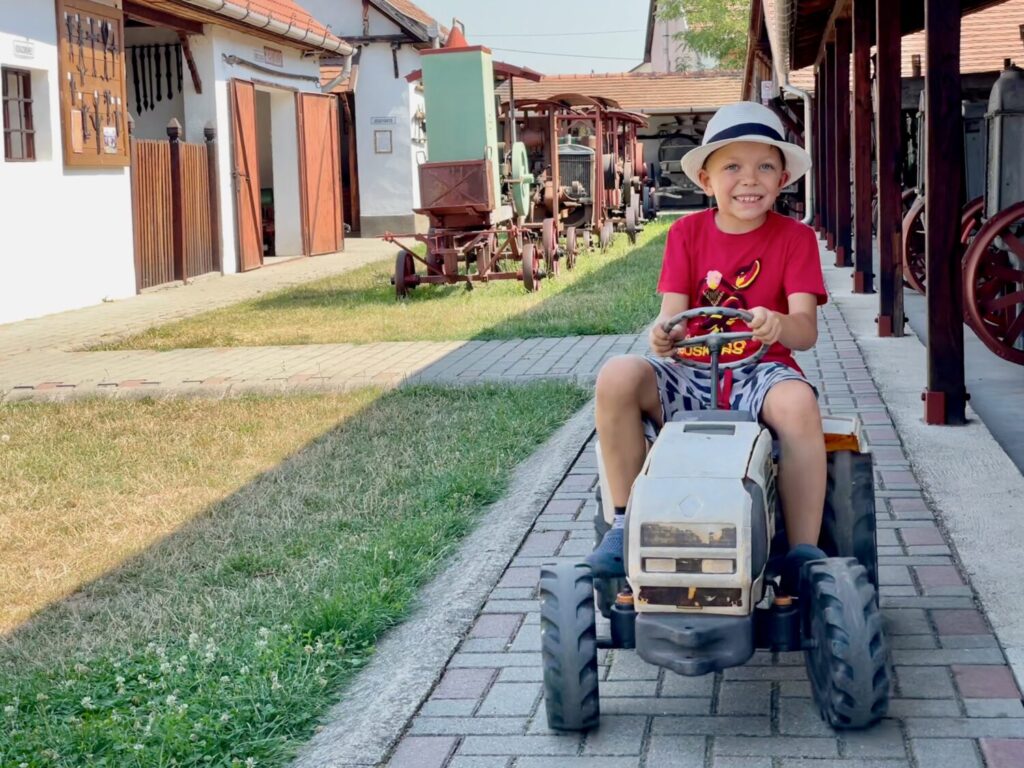
The Story Behind the János Hajdu Ráfis Agricultural Machinery Museum
The passion of János Hajdu Ráfis, a former farmer turned factory worker, and his wife Mária Bakos for agricultural machinery gave life to one of the most original museums in Hungary. The museum began when they decided to donate their private collection to the Hungarian State in 1979, turning a personal passion into a heritage of national importance.
If you imagine their home garage full of old tractors, think much bigger. The first collection included around 250 motorised agricultural machines and over 1,000 hand tools, an impressive number that would make any collector envious today.
The collection grew rapidly in the following years, reaching over 2,600 items displayed across more than 2,600 square metres of exhibition space, including farm buildings and open-air areas. In 1984, the museum expanded with new halls on an adjacent plot on Eötvös Street. In 1993, it officially opened under the name Mezőgazdasági Gépmúzeum, known in English as the Agricultural Machinery Museum.
Today, it is one of Mezőkövesd’s main attractions and a museum of national significance, housing one of the largest collections of agricultural machinery in Hungary. Every year, on the first Saturday of September, the museum hosts the National Gathering of Agricultural Machines (Országos Mezőgazdasági Gépésztalálkozó). On this day, visitors from all over the country come to Mezőkövesd to enjoy parades of historical tractors, mechanical demonstrations, blacksmith workshops and activities for children, turning the museum into a lively celebration of rural heritage.
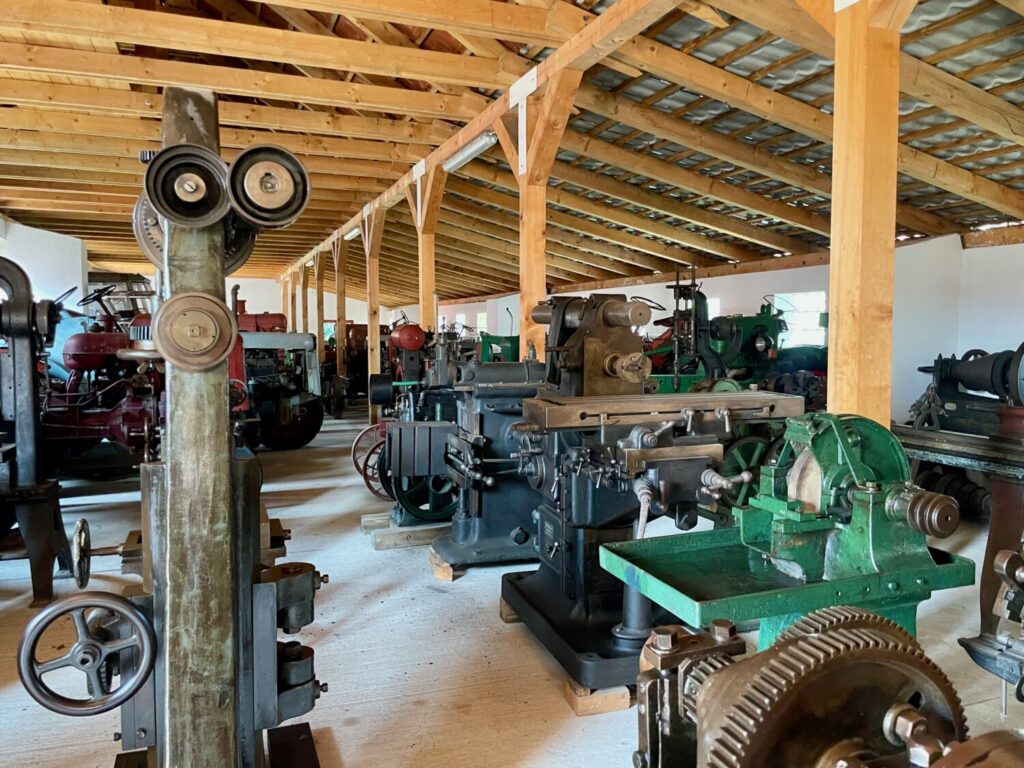
What to See at the Mezőkövesd Agricultural Machinery Museum
The Mezőkövesd Agricultural Machinery Museum is not a traditional museum. It’s more like a real working farm, where each building tells a different chapter of Hungary’s rural history. You can see countless tractors, engines and farming tools, taking a real journey back in time through the inventions that changed agricultural life.
In the halls dedicated to engines and farming machines, you can admire locomotives, petrol and diesel engines, mills, pumps and old gear systems that once powered the countryside. Walking among all these machines is a truly unique and surreal experience.
I had never seen such a vast collection of agricultural equipment before. Imagine rows of twenty or more similar machines, all perfectly preserved and some still in working order.
My son especially loved the tractors you can climb on in the courtyard, a favourite for children visiting the museum. However, I do not have a single photo of him on a real tractor because he never left his little plastic pedal tractor, which he rode around the museum the entire time.
It is definitely one of the most fun activities for kids, and something I highly recommend including in your visit. It’s free and included in your ticket. Your kids just have to find a free toy tractor and ride it.
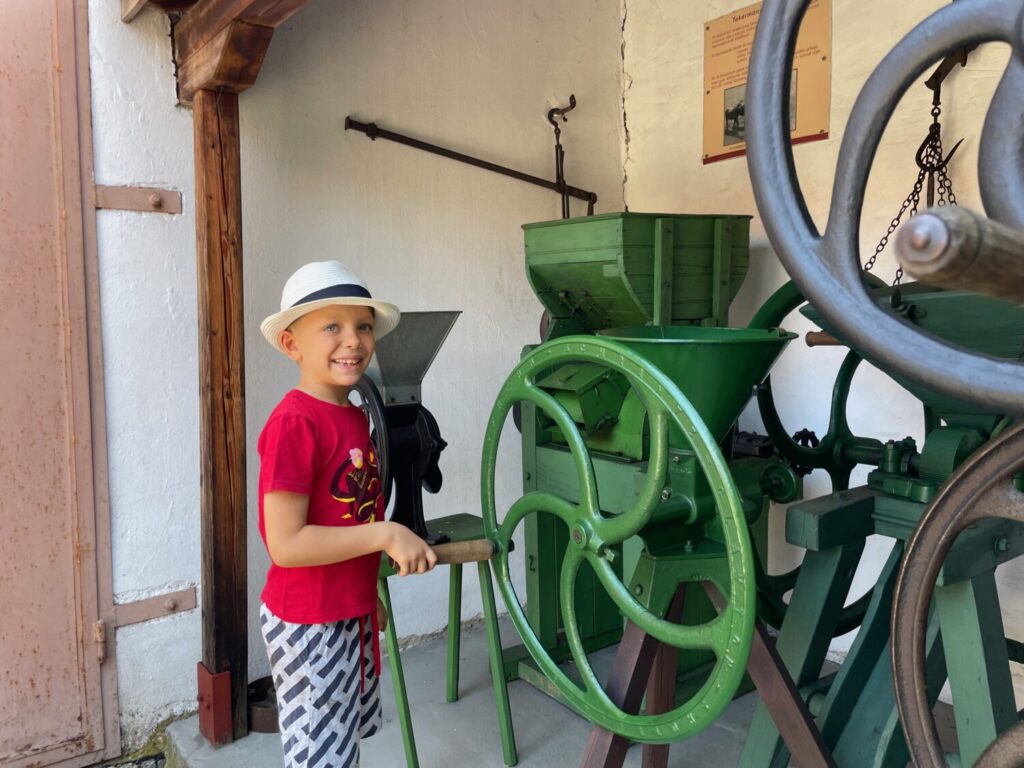
Step into the Past: The Traditional Hungarian Farmyard
In the museum, you can explore a reconstruction of a typical ólaskert, a group of nineteenth-century farmyards. Peasant families once lived in a house surrounded by stables, barns and storage sheds.
The main building is the heated stable (tüzelős ól), built from mud and straw, with one area for the animals and a small space where the farmer slept even during the winter. Inside, you can see chimneyless fireplaces made of stone and clay, used for cooking and heating.
This section offers visitors a fascinating glimpse into everyday rural life in nineteenth-century Hungary. At that time, farming, animal care and family life were deeply connected.
Historic Petrol-Powered Locomotives and Early Farm Engines
The museum houses around sixty large petrol-powered locomotives, built between the late nineteenth century and the 1930s. These impressive machines, weighing between two and three tonnes, were used to power threshers, saws, and presses before tractors became widespread. The oldest models date back to 1899, produced by Mayer-féle Gépgyár in Szombathely, and ran on either petrol or kerosene.
Some of them were later converted into self-propelled vehicles by local mechanics in the 1920s and 1930s. Among the rarest pieces are a wood-gas locomotive and a mixed-fuel HSCS model, remarkable examples of Hungarian ingenuity and adaptability that reflect how farmers made the most of the available resources.
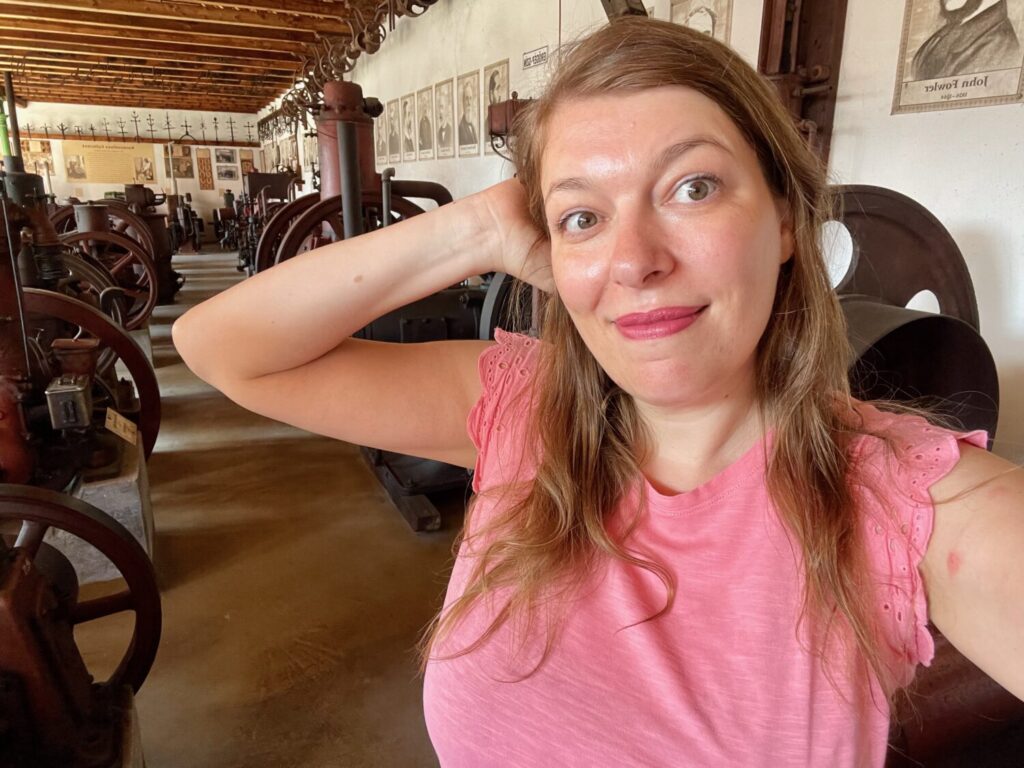
Industrial-Era Farm Machinery and Vintage Tractors
One section of the museum is dedicated to agricultural machines produced by Hungarian industry between 1880 and 1950, showing the evolution of technology in the fields. Here you can see steam engines, threshers, mills, water pumps and seed-cleaning machines. Many pieces come from historic Hungarian factories, such as Hoffer, HSCS, Kühne, MÁVAG, and Höcker, all located in Budapest.
Among the rarest models are a Höcker steam engine from 1904 and a Láng Gépgyár stationary machine from 1905, both still in working condition. At the János Hajdu Ráfis Agricultural Machinery Museum, you can also admire hydraulic mills, turbines and an old oil-seed press, which demonstrate the ingenuity and craftsmanship of early agricultural engineering.
Self-propelled machines first appeared in the 1920s and revolutionised farming. The museum displays both Hungarian and American models, arranged in chronological order, so you can follow their development from iron wheels to modern rubber tyres and diesel engines. Before visiting the Gépmúzeum in Mezőkövesd, I had no idea that the earliest tractors actually had iron wheels!
A significant part of the museum exhibits internal combustion engines and stationary motors. There are over 100 examples that once powered pumps, mills, workshops and farm machinery. With the advent of electricity, Ganz-Jendrassik and Láng generators, dating from 1890 to 1940, became an integral part of farm life and significantly transformed rural work and production.
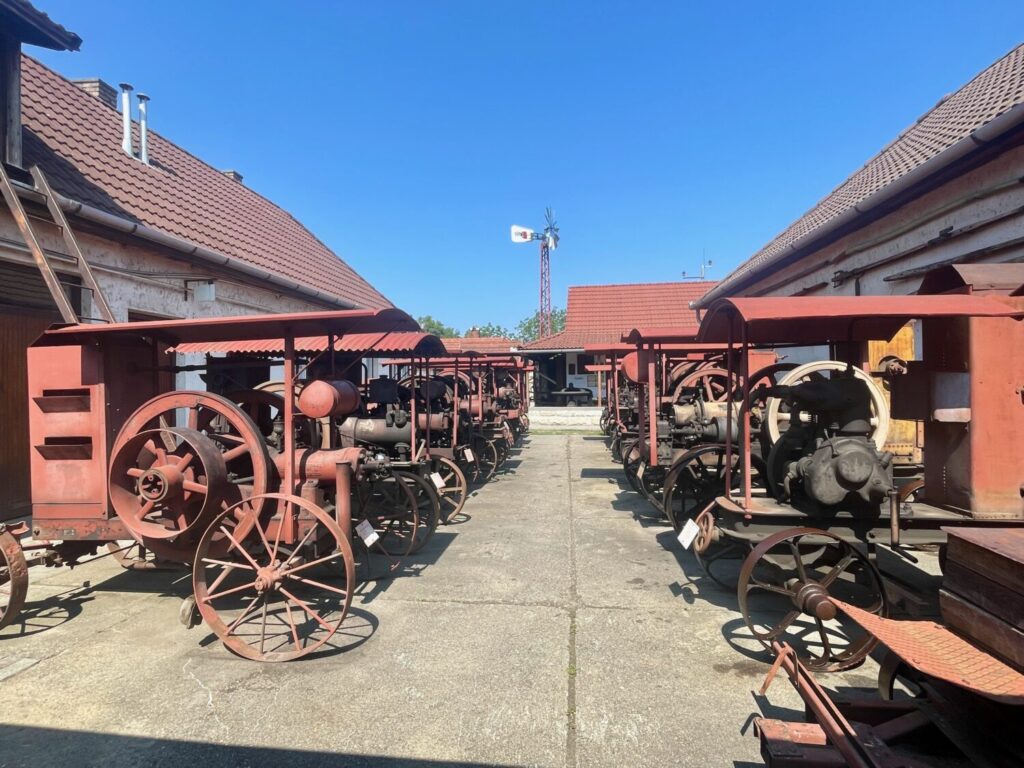
Everyday Tools of Hungary’s Small Farmers
The Mezőkövesd Agricultural Machinery Museum also displays a rich collection of tools used by local farming families, offering a glimpse into traditional rural life. You can see wooden ploughs, harrows, iron rollers, sieves and many other instruments. Farmers used them in small farms during the nineteenth and twentieth centuries, before motorised machines became widespread.
An entire section is devoted to the traditional Hungarian blacksmith’s craft, featuring decorative wrought ironwork, hand tools and farming equipment that highlight the exceptional skill and creativity of these artisans. You can also explore a fascinating display of wine-making tools, reflecting the importance of viticulture in Mezőkövesd’s rural microeconomy and its deep connection to local traditions.
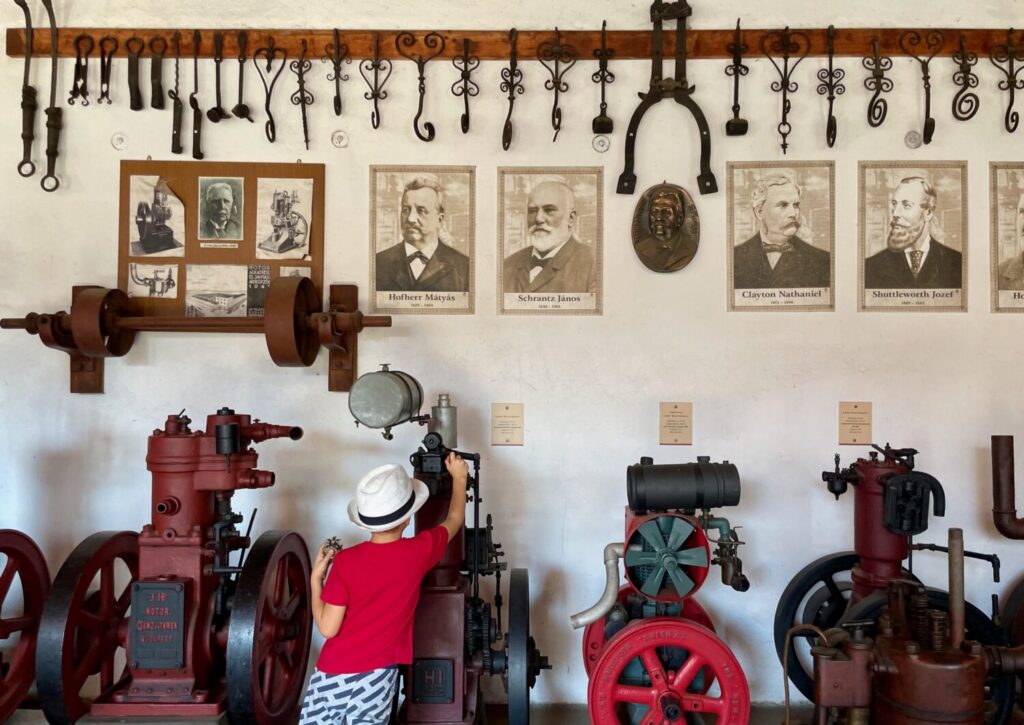
Essential Tips for Visiting the Mezőkövesd Agricultural Machinery Museum
The Mezőkövesd Agricultural Machinery Museum is one of the largest of its kind in Central Europe. It is perfect to visit with children who love tractors or mechanics, as they can touch everything and move around freely.
Almost the entire exhibition is outdoors, and you can explore the museum in a couple of hours. Keep in mind that summers are very hot, so bring water, a hat, and sunscreen. In winter, you will need warm clothes and comfortable shoes. There is no café or restaurant inside the museum, but you can refill your water bottle at a fountain or from the taps in the bathrooms.
Throughout the year, the museum organises local events and demonstrations, mainly for Hungarian visitors, so they may not be very relevant for tourists unless you speak the language. The permanent exhibition is still well worth a visit, as it features an impressive number of agricultural machines you are unlikely to find anywhere else.
Opening Times for the Mezőkövesd Agricultural Machinery Museum
The opening hours of the Mezőkövesd Agricultural Machinery Museum vary depending on the season. From 1 November to 31 March, the museum is open Tuesday to Saturday from 9:00 am to 3:00 pm. From 1 April to 31 October, it is open Tuesday to Sunday from 9:00 am to 5:00 pm. As always, it is a good idea to check the official website for up-to-date information before your visit, as opening times may change during holidays or special events.
Tickets and Prices for the Mezőkövesd Gépmúzeum
The full ticket costs 1,600 HUF (around €4). Admission is free for children under 6 and visitors over 70. Discounts are available for students, as well as combined tickets that include other attractions in Mezőkövesd, such as the Matyó Museum and the Takács István Gallery. These are a great option if you want to explore more of the city’s traditional and artistic culture alongside the tractor museum.
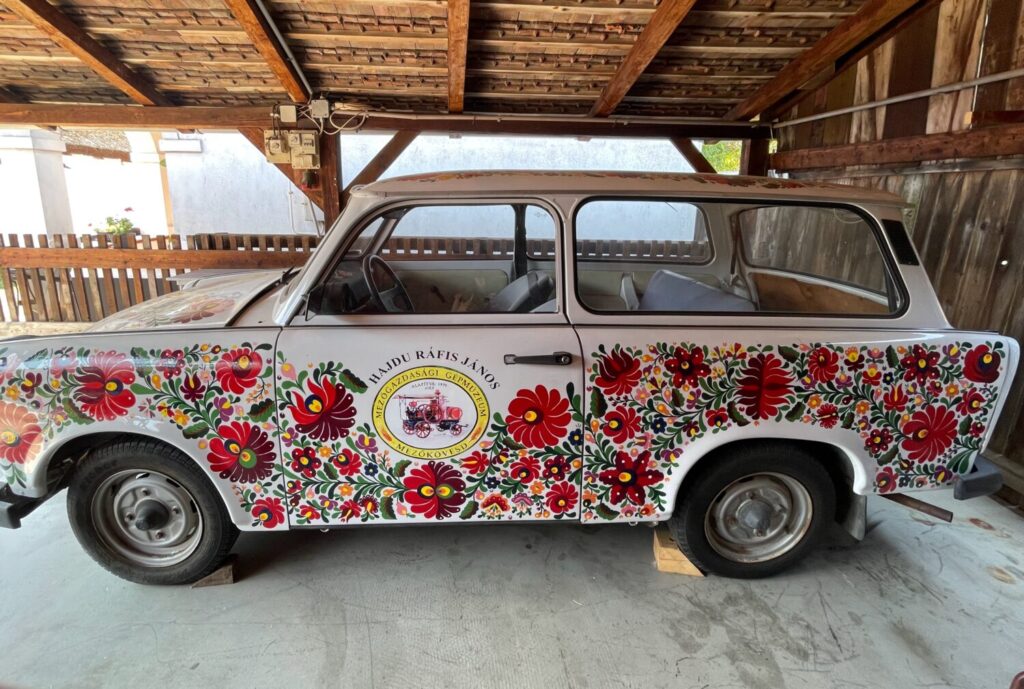
How to Reach the János Hajdu Ráfis Agricultural Machinery Museum
The János Hajdu Ráfis Agricultural Machinery Museum is located in the centre of Mezőkövesd. It’s just a short walk from the Hadas district, where you can visit the traditional Matyó houses. The museum is easy to reach by car or on foot from the train station.
If you are driving from Budapest, take the M3 motorway to Mezőkövesd. The journey takes about one and a half hours. Several parking spots are available along the streets near the museum. We left our car in the private parking area of our apartment and explored the city centre on foot.
If you prefer to use public transport, there is a direct train from Budapest to Mezőkövesd. It takes about one and a half hours. From the train station, the museum is about a 20-minute walk through the town centre.
Hajdu Ráfis János Mezőgazdasági Gépmúzeum
(Hajdu Ráfis János Agricultural Machinery Museum)
Eötvös utca 32, 3400 Mezőkövesd
Best Things to See Near Mezőkövesd and the Gépmúzeum
The town of Mezőkövesd is renowned for the Matyó community. Their craftsmanship has been recognised as Intangible Cultural Heritage by UNESCO. I recommend visiting the Hadas district, where you can see the traditional Matyó houses. They’re unique to this region, and you can find similar examples only in ethnographic villages, such as Skanzen in Szentendre.
To relax after your museum visit, head to the Zsóry Fürdő thermal bath, just a few kilometres from the town centre. It’s famous for its healing and mineral-rich waters, surrounded by peaceful green areas perfect for families.
If this article has inspired you to explore Mezőkövesd and its fascinating Agricultural Machinery Museum, leave a comment below. Share your experience of this unusual yet incredibly engaging museum that both adults and children will enjoy!
